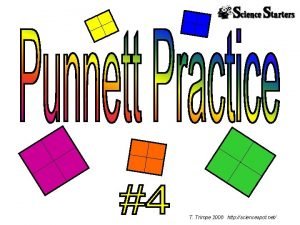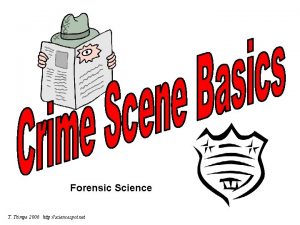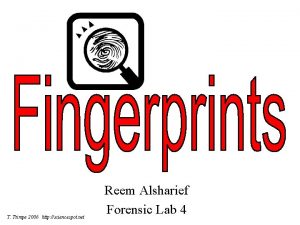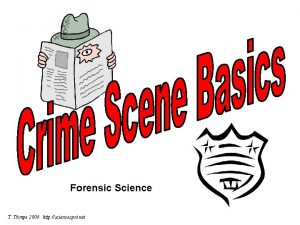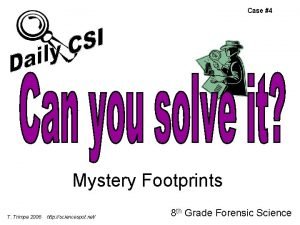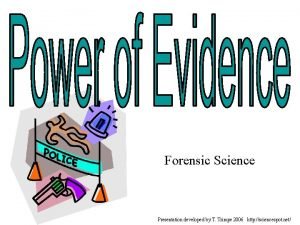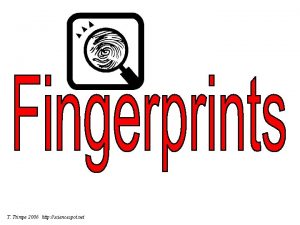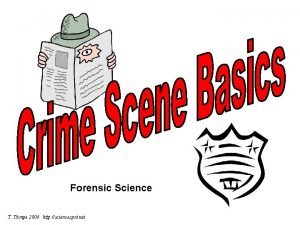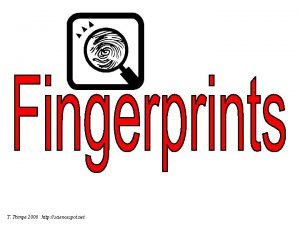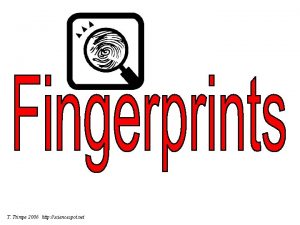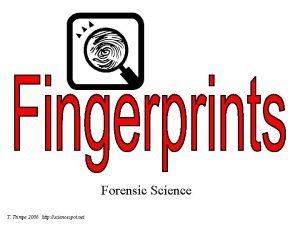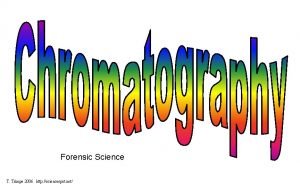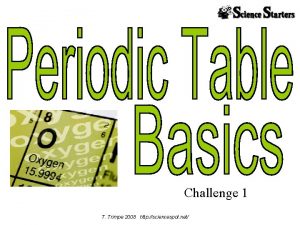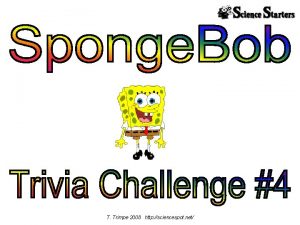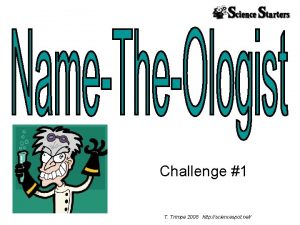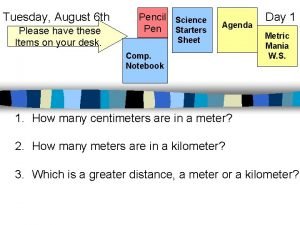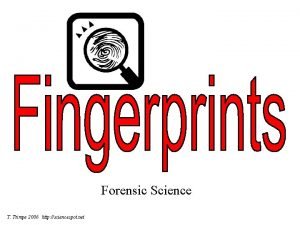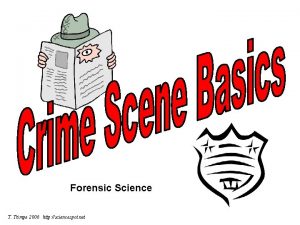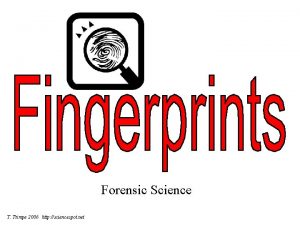T Trimpe 2006 http sciencespot net What is






































- Slides: 38

T. Trimpe 2006 http: //sciencespot. net

What is a Fingerprint? • Skin has an outer layer (epidermis) which has ridges projecting inward, and an inner layer (dermis) which has projections pressing into the spaces between ridges • A fingerprint is a pattern made by the friction ridges, which is left behind due to sweat and oil that sticks to them. • Fingerprints form during the fetal stage of development. • Pattern based on genetics, detail somewhat random • Identical twins do not have identical fingerprints 2

When/How are Fingerprints Used? • Providing biometric security – Control access to secure areas • Identifying victims – Amnesia victims/unknown deceased (victims of major disasters) • Background checks – Security clearance, weapon permits, government employment • As evidence – Left behind on broken glass/skin/on a safe

Fingerprint Principles According to criminal investigators, fingerprints follow 3 fundamental principles: • A fingerprint is an individual characteristic; no two people have been found with the exact same fingerprint pattern. • A fingerprint pattern will remain unchanged for the life of an individual; however, the print itself may change due to permanent scars and skin diseases. • Fingerprints have general characteristic ridge patterns that allow them to be systematically identified.

Fingerprint Classes There are 3 specific classes for all fingerprints based upon their visual pattern: arches, loops, and whorls. Each group is divided into smaller groups as seen in the lists below. Arch Plain arch Tented arch Loop Radial Loop Ulnar loop Whorl Plain whorl Central pocket whorl Double loop whorl Accidentical

Interesting Info Fingerprint Factoid: 60% of people have loops, 35% have whorls, and 5% have arches Did you know? Dactyloscopy is the study of fingerprint identification. Police investigators are experts in collecting “dactylograms”, otherwise known as fingerprints.

Fingerprints There are 3 types of fingerprints Visible/Patent – left by dirt, grease, blood, etc. 1. § Does not need processing

Fingerprints There are 3 types of fingerprints Impression/Plastic – indentation in soft material (butter, putty, tar, etc. ) 2. § Does not need processing

Fingerprints There are 3 types of fingerprints 3. Latent – requires processing to make visible and suitable for analysis

Fingerprints How are fingerprints analyzed? Patterns Arch Loop Whorl

Arches are the simplest type of fingerprints that are formed by ridges that enter on one side of the print and exit on the other. No deltas are present. Spike or “tent” Plain Arch Ridges enter on one side and exit on the other side. Tented Arches Similar to the plain arch, but has a spike in the center.

bsapp. com

Loops must have one delta and one or more ridges that enter and leave on the same side. These patterns are named for their positions related to the radius and ulna bones. Delta Ulnar Loop (Right Thumb) Loop opens toward right or the ulna bone. Radial Loop (Right Thumb) Loop opens toward the left or the radial bone. NOTE: On the left hand, a loop that opens to the left would be an ulnar loop, while one that opens to the right would be a radial loop.

bsapp. com

bsapp. com

Whorls have at least one ridge that makes (or tends to make) a complete circuit. They also have at least two deltas. If a print has more than two deltas, it is most likely an accidental. Plain Whorl Central Pocket Whorl Draw a line between the two deltas in the plain and central pocket whorls. If some of the curved ridges touch the line, it is a plain whorl. If none of the center core touches the line, it is a central pocket whorl.

bsapp. com

bsapp. com

Whorls – Part 2 Double Loop Whorl Accidental Whorl Delta Double loop whorls are made up of any two loops combined into one print. Accidental whorls contain two or more patterns (not including the plain arch), or does not clearly fall under any of the other categories.

bsapp. com

bsapp. com

Identify each fingerprint pattern. Right Hand Left Hand

A Closer Look at Fingerprints Forensic Science Image from ftp: //sequoyah. nist. gov/pub/nist_internal_reports/ir_6534. pdf T. Trimpe 2007 http: //sciencespot. net/

Ridgeology: The study of the uniqueness of friction ridge structures and their use for personal identification. As we have learned in our first lesson, a fingerprint is made of a series of ridges and valleys on the surface of the finger. The uniqueness of a fingerprint can be determined by the pattern of ridges and valleys as well as the minutiae points, which are points where the ridge structure changes. The koala is one of the few mammals (other than primates) that has fingerprints. In fact, koala fingerprints are remarkably similar to human fingerprints; even with an electron microscope, it can be quite difficult to distinguish between the two.


Fingerprint Identification When minutiae on two different prints match, these are called points of similarity or points of identification. At this point there is no international standard for the number of points of identification required for a match between two fingerprints. However, the United Kingdom requires a minimum sixteen points while Australia requires twelve. Fact! A single rolled print may have 100+ identification points. Automated Fingerprint Identification System (AFIS) AFIS is a computerized system capable of reading, classifying, matching, and storing fingerprints for criminal justice agencies. Quality latent fingerprints are entered into the AFIS for a search for possible matches against the state maintained databases for fingerprint records to help establish the identity of unknown deceased persons or suspects in a criminal case. http: //www. fdle. state. fl. us/Crime. Lab/images/fingerrint%20 comparison%20 for%20 afis. jpg

Fingerprints Computer software compares the location of these minutiae.

Comparison There are no legal requirements in the United States on the number of points. Generally, criminal courts will accept 8 to 12 points of similarity. Kendall/Hunt Publishing Company 28

Ridge Characteristics Use these characteristics as points of identification when comparing fingerprint samples. The more points you can find in common, the better the match!

Ridge Characteristics Minutiae—characteristics of ridge patterns § § § § § Ridge ending Short ridge Dot or fragment Bifurcation Double bifurcation Trifurcation Bridge Island Enclosure Spur Kendall/Hunt Publishing Company 30


Fingerprint Minutiae Kendall/Hunt Publishing Company 32

FINGERPRINT MATCHING • • Directions: Can you match this latent print lifted from the crime scene (below) to any of the suspects’ on the next 2 slides? First try to determine the main type, and then try to match the details. Label as many reference points as you can. Circle minutiae on both the crime scene print and the suspect prints, identify the basic patterns (loop, arch or whorl) and perform a ridge count. Crime Scene Print

Suspect Prints Page 1

Suspect Prints Page 2

Forensic Science

Latent prints are impressions left by friction ridge skin on a surface, such as a tool handle, glass, door, etc. Prints may be collected by revealing them with a dusting of black powder and then lifted with a piece of clear tape. Did you know? Camel hair is the most common animal hair used to make fingerprint brushes. Now many brushes (like the one above) are made out of fiberglass.

• How to lift a Latent Fingerprint Review the attached video to learn how to lift a latent fingerprint
 T. trimpe 2006 http //sciencespot.net/
T. trimpe 2006 http //sciencespot.net/ T. trimpe 2002 http //sciencespot.net/
T. trimpe 2002 http //sciencespot.net/ Http //sciencespot.net/ answers
Http //sciencespot.net/ answers Microscopes brainpop quiz answers
Microscopes brainpop quiz answers Http //sciencespot.net/
Http //sciencespot.net/ T. trimpe 2006 http //sciencespot.net/
T. trimpe 2006 http //sciencespot.net/ Http://sciencespot.net/
Http://sciencespot.net/ T. trimpe 2006 http //sciencespot.net/
T. trimpe 2006 http //sciencespot.net/ T trimpe 2006 http //sciencespot.net/ answer key
T trimpe 2006 http //sciencespot.net/ answer key Http://sciencespot.net/
Http://sciencespot.net/ T. trimpe 2006 http://sciencespot.net/
T. trimpe 2006 http://sciencespot.net/ Http://sciencespot.net/
Http://sciencespot.net/ T. trimpe 2006 http //sciencespot.net/
T. trimpe 2006 http //sciencespot.net/ T.trimpe 2006 http sciencespot.net
T.trimpe 2006 http sciencespot.net Sciencespot.net fingerprint challenge
Sciencespot.net fingerprint challenge Sciencespot.net
Sciencespot.net Sciencespot.net fingerprint challenge
Sciencespot.net fingerprint challenge Sciencespot fingerprint challenge
Sciencespot fingerprint challenge T. trimpe 2006 http //sciencespot.net/
T. trimpe 2006 http //sciencespot.net/ T. trimpe 2006 http://sciencespot.net/
T. trimpe 2006 http://sciencespot.net/ T. trimpe 2006 http //sciencespot.net/
T. trimpe 2006 http //sciencespot.net/ T. trimpe 2006 http //sciencespot.net/
T. trimpe 2006 http //sciencespot.net/ T. trimpe 2006 http //sciencespot.net/ answer key
T. trimpe 2006 http //sciencespot.net/ answer key T. trimpe 2008 http://sciencespot.net/
T. trimpe 2008 http://sciencespot.net/ T trimpe
T trimpe T. trimpe 2008 http //sciencespot.net/
T. trimpe 2008 http //sciencespot.net/ Parts of tulip flower
Parts of tulip flower T. trimpe 2007 http //sciencespot.net/
T. trimpe 2007 http //sciencespot.net/ I am a halide with 6 energy levels
I am a halide with 6 energy levels Plastic fingerprints
Plastic fingerprints Https //sciencespot.net answers
Https //sciencespot.net answers T.trimpe 2003 http //sciencespot.net/ answers
T.trimpe 2003 http //sciencespot.net/ answers T trimpe 2003 http sciencespot net crossword answers
T trimpe 2003 http sciencespot net crossword answers T. trimpe 2008 http://sciencespot.net/
T. trimpe 2008 http://sciencespot.net/ Regents
Regents T. trimpe 2008 http://sciencespot.net/
T. trimpe 2008 http://sciencespot.net/ T. trimpe 2004 http //sciencespot.net/
T. trimpe 2004 http //sciencespot.net/ T. trimpe 2008 http //sciencespot.net/
T. trimpe 2008 http //sciencespot.net/ T. trimpe 2011 http://sciencespot.net/
T. trimpe 2011 http://sciencespot.net/


